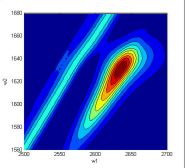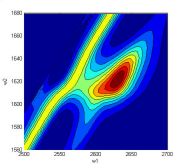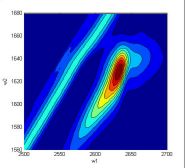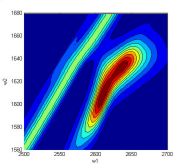
These programs feature the ability to simulate FWM vibrational spectra while including the effects of:
- Gaussian laser pulsewidths (transform limited only)
- absorption and refractive index changes
- other lower-order non-linear optical artifacts
- spectral resolution of output via monochromator
- inhomogeneous broadening and correlations of modes
- window contributions and phasematching factors for small angle input geometries
- time delays between laser pulses.
Created using one of these programs, example simulations here show changes that two nearby peaks make with each other based on a change in sign of a molecular parameter. The peaks are inhomogeneously broadened to a moderate degree. The first image uses parameters typical for real fits to real data, the second changes the sign of the product of transition dipoles of one of the peaks, the third changes the sign of the correlation factor of the top peak, and the fourth changes the correlation factor sign of the bottom peak. (The diagonal is a reference line for normalizing purposes...the two peak locations are best noticed in the last of the four images, as effects in the first 3 tend to distort and/or blend together the two.)
In FWM, it is not expected for the sign of a product to be different between nearby peaks (and it is impossible to study this feature in common spectroscopies like IR or Raman), but DOVE-based FWM (for which these images were generated for...see graduate research group link below) may in principle be used to discover such a phenomenon, thereby proving the "signness" of vibrational transition dipoles and/or polarizabilities.
These modeling programs serve a purpose in determining if the multi-dimensional methods can uncover features that standard spectroscopic methods cannot, as in the discussion above. In addition, the programs assist in verifying the peaks are real (That is, they are not an artifact of other interfering phenomena, specifically lower-order ones. (They do not treat HIGHER-order ones, which are often very interesting!) )
My post-doctoral research group at Oak Ridge National Laboratory currently has a large number of projects. And here is a link to my graduate research group, from which the above discussion of multi-dimensional spectroscopy originates.



